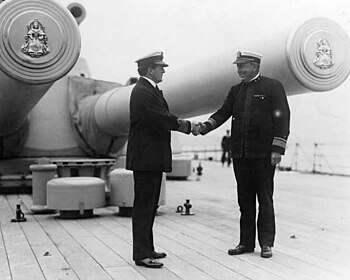Naval heraldry is a form of identification used by naval vessels from the end of the 19th century onwards, after distinguishing features such as figureheads and gilding were discouraged or banned by several navies.

Naval heraldry commonly takes the form of a badge, seal, crest, or coat of arms designed specifically for a ship[a] (or a series of ships bearing the same name), which in Commonwealth navies takes the form of a large plaque, referred to as the ship's badge, mounted on the superstructure of the ship, and in the United States Navy is known as the ship's seal or ship's crest, and is primarily found on crew uniform patches.
An item of naval heraldry is seen as the identifying logo of the vessel, and is commonly reproduced on hats, stationery, trophies, souvenirs, and gifts related to the ship.[a] In many navies, the ship's badge is also displayed on the tampions – the covers for the gun muzzles.[1]
The naval heraldric tradition follows the heraldic traditions of the country, with some distinctive variations.
Cite error: There are <ref group=lower-alpha> tags or {{efn}} templates on this page, but the references will not show without a {{reflist|group=lower-alpha}} template or {{notelist}} template (see the help page).
- ^ Major, Alan P. (1 April 1981). Maritime antiques: an illustrated dictionary. A. S. Barnes. p. 209. ISBN 978-0-498-02496-2.
© MMXXIII Rich X Search. We shall prevail. All rights reserved. Rich X Search
